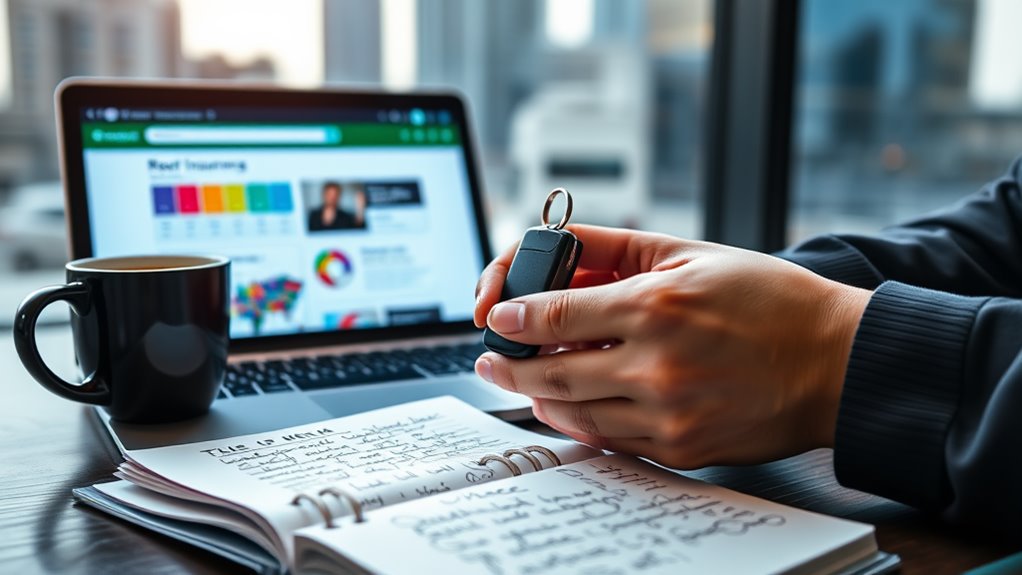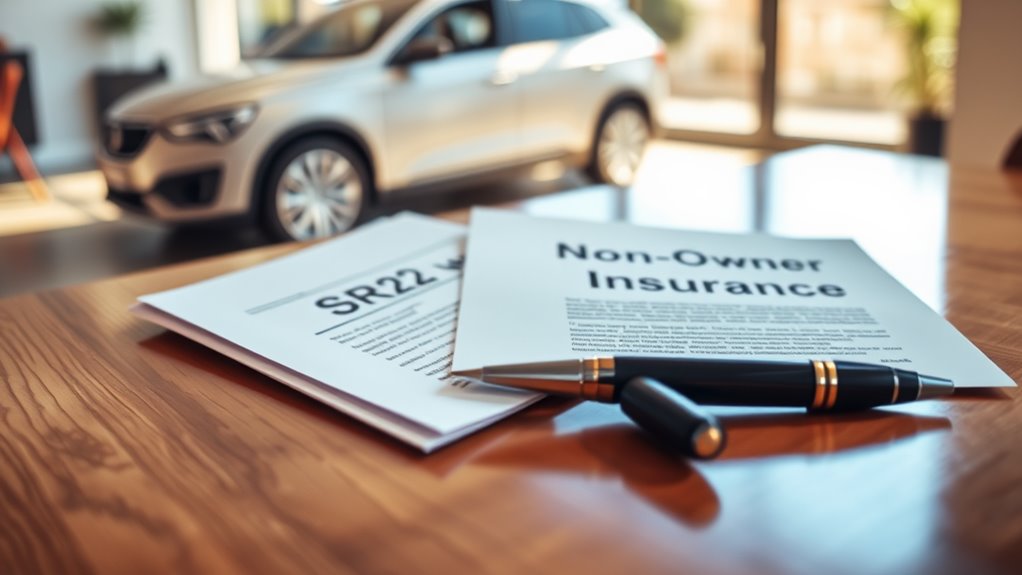If you're exploring alternatives to SR22 insurance, non-owner insurance might be worth considering. This type of coverage offers liability protection for those who frequently rent or borrow vehicles without owning one. It can also be a cost-effective solution for maintaining continuous coverage and meeting state requirements. However, understanding the specifics of non-owner insurance is essential. What benefits does it really offer, and who qualifies for it? Let's uncover the details.
Key Takeaways
- Non-owner insurance provides liability coverage without owning a vehicle, ideal for drivers borrowing or renting vehicles frequently.
- It serves as secondary coverage, activating after the owner's policy limits are exhausted, ensuring financial protection.
- Non-owner policies are typically more affordable than standard car insurance, making them a cost-effective alternative for high-risk drivers.
- Maintaining non-owner insurance helps prevent gaps in coverage history, potentially lowering future premium rates.
- Check state-specific requirements, as some states mandate non-owner insurance for high-risk drivers with infractions.
Understanding Non-Owner Insurance Basics

When you don't own a car but occasionally drive others' vehicles, understanding non-owner insurance basics becomes vital. This type of liability insurance protects you when you're behind the wheel of someone else's car, particularly if you frequently rent or borrow vehicles. However, it's important to highlight that non-owner insurance typically excludes collision or extensive coverage for the borrowed vehicle. It acts as secondary coverage, only kicking in once the owner's policy limits are reached. Additionally, some states may require non-owner insurance for high-risk drivers with significant traffic infractions. Non-owner car insurance ensures financial protection in case of accidents while driving non-owned vehicles. It's also worth noting that in Ohio, SR-22 insurance may be necessary for certain high-risk drivers, which can influence your insurance options. Remember, if you live with a vehicle owner, this insurance isn't an option for you. Knowledge of these factors helps guarantee you're adequately protected while driving non-owned vehicles.
Key Benefits of Non-Owner Insurance
Non-owner insurance offers several key benefits that enhance your driving experience, particularly if you frequently share or rent vehicles.
First, it provides essential financial protection from liability, covering bodily injury and property damage to others while you drive. This type of insurance is often more affordable than standard policies since it doesn't tie you to a specific vehicle.
Additionally, it guarantees legal compliance, fulfilling state minimum requirements and preventing gaps in your insurance history. This can help keep your future premium rates lower.
Moreover, non-owner insurance adds flexibility, allowing you to maintain continuous coverage without owning a car, making it a convenient option for those who rent or borrow vehicles often.
Eligibility Criteria for Non-Owner Policies
Understanding the eligibility criteria for non-owner policies is essential, especially if you're considering this insurance option.
First, you mustn't own a vehicle, as non-owner policies cater specifically to those in this situation. If you have a poor driving record or are classified as a high-risk driver, this insurance may be necessary for you.
Additionally, regular driving of borrowed or rented vehicles often necessitates this coverage. You'll also need to comply with your state's minimum insurance requirements, which vary by location.
Finally, if you're seeking license reinstatement after a suspension, proving financial responsibility through a non-owner policy might be required. Be sure to review these factors carefully to guarantee you meet the eligibility criteria.
Coverage Options Available With Non-Owner Insurance

While exploring your insurance options, it's important to recognize the diverse coverage available with non-owner insurance. This type of policy primarily offers liability coverage, which protects you against bodily injury and property damage claims from accidents.
Some providers may also offer medical payments coverage and uninsured/underinsured motorist protection, which is vital if you encounter drivers lacking adequate insurance. However, keep in mind that non-owner insurance doesn't cover the vehicle you're driving.
Some insurers include medical payments and uninsured motorist protection, but remember, non-owner insurance doesn't cover the vehicle itself.
Major insurers like Nationwide, Progressive, and GEICO provide various options, while Dairyland Insurance focuses specifically on frequent car borrowers.
Additionally, in certain states, you might find policies that include personal injury protection (PIP), enhancing your coverage options even further.
Factors Influencing Non-Owner Insurance Costs
When choosing non-owner insurance, several factors can greatly affect your premiums. State-specific insurance requirements can lead to varying minimum coverage mandates, directly impacting your costs.
Your driving history plays an essential role, as past accidents or violations typically result in higher rates. Additionally, your location matters; living in urban areas with higher crime and accident rates usually means increased premiums.
Personal factors like age and gender also influence perceived risk, with young drivers and males often facing higher costs.
Finally, your credit score can notably sway your premiums, as good credit often indicates financial responsibility, while poor credit typically leads to increased rates.
Understanding these factors helps you anticipate and manage your non-owner insurance costs effectively.
Tips for Finding Affordable Non-Owner Insurance
How can you secure affordable non-owner insurance without sacrificing coverage? Start by comparing quotes from multiple providers like GEICO and State Farm, as prices can vary by state.
Take advantage of available discounts, such as those for safe driving or bundling policies, which can greatly reduce your premium. Since non-owner policies typically require direct contact for quotes, don't hesitate to reach out to agents for tailored options.
Explore discounts for safe driving and policy bundling to significantly lower your non-owner insurance premium. Contact agents for personalized quotes.
Assess your coverage needs carefully; opting for minimum liability coverage can be more cost-effective.
Finally, maintain a clean driving record to help lower your premiums over time. By employing these strategies, you can find non-owner insurance that fits your budget while ensuring you have adequate protection.
Comparison of Non-Owner Insurance to SR22 Requirements

Understanding the differences between non-owner insurance and SR22 requirements is crucial for drivers seeking to navigate their insurance options effectively.
SR22 serves as proof of financial responsibility for high-risk drivers, while non-owner insurance provides liability coverage for those without a vehicle. Typically, SR22 is required after serious infractions, whereas non-owner insurance is available to anyone who doesn't own a car.
Cost-wise, non-owner insurance is often more affordable, as it covers fewer risks. Additionally, while SR22 guarantees compliance with state minimums regardless of vehicle ownership, non-owner insurance acts as secondary coverage when driving borrowed vehicles.
Ultimately, non-owner insurance can fulfill SR22 requirements, offering flexibility for non-car owners to remain compliant.
Conclusion
In summary, non-owner insurance offers a sensible solution for savvy drivers seeking security without the stigma of SR22. By prioritizing protection, price, and personal needs, you can pave the path to premium coverage. This prudent pick not only provides peace of mind but also promotes compliance with state regulations, ensuring you stay on the right route. So, if you're maneuvering through the complexities of insurance options, consider non-owner policies as a strategic step toward safer driving.



